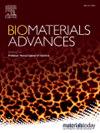Sustained growth factor release driven cellular therapy indicates enhanced potential for regeneration upon mechanical injury
IF 5.5
2区 医学
Q2 MATERIALS SCIENCE, BIOMATERIALS
Materials Science & Engineering C-Materials for Biological Applications
Pub Date : 2025-06-21
DOI:10.1016/j.bioadv.2025.214389
引用次数: 0
Abstract
Mesenchymal stem cells (MSCs) are characterised by excellent plasticity and clonogenic potential, thus rendering them great candidates for the development of cellular therapies against damaged tissues where regeneration is needed. Nevertheless, their multipotency becomes significantly affected upon removal from their natural niches, signifying the need for developing efficient methods that will preserve their regenerative and immunomodulatory capacity. It is crucial to protect these properties beyond traditional modelling, ensuring scalability to large numbers, which will optimise their potential for use in cellular therapies. In this study, a combination of strategies was implemented to maximise the preservation of MSC multipotent phenotype, such as their growth as spheroids and their incorporation into non-bioactive polyethylene glycol (PEG)-hydrogels. Importantly, we further propose that the use of a novel continuous growth factor (GF) release technology in a crystal form can be locally administered inside the MSC spheroids. This establishes an intimate, responsive connection between the crystals and the cells, where the cell-induced degradation stimuli are proportional to the corresponding release of GFs that they receive. We report that the gradual release of NGF-β acts superiorly compared to the conventional soluble form while conferring important benefits on spheroids, such as cytoprotection from stress as well as higher persistence of multipotent markers. Subsequently, the enhanced retention translates to a more responsive phenotype upon mechanical injury, initiation of migration and upregulation in expression of markers that facilitate cytoskeletal rearrangement and homing to damaged tissues.

持续生长因子释放驱动的细胞治疗表明机械损伤后再生的潜力增强
间充质干细胞(MSCs)具有良好的可塑性和克隆潜能,因此使其成为开发针对需要再生的受损组织的细胞疗法的重要候选者。然而,从自然生态位移除后,它们的多能性会受到显著影响,这表明需要开发有效的方法来保持它们的再生和免疫调节能力。在传统建模之外保护这些特性是至关重要的,确保大规模的可扩展性,这将优化它们在细胞治疗中的应用潜力。在这项研究中,实施了一系列策略来最大限度地保留MSC多能表型,例如将其作为球体生长并将其掺入无生物活性的聚乙二醇(PEG)-水凝胶中。重要的是,我们进一步提出使用晶体形式的新型连续生长因子(GF)释放技术可以在MSC球体内局部施用。这在晶体和细胞之间建立了一种密切的、响应性的联系,其中细胞诱导的降解刺激与它们接收到的相应的GFs释放成正比。我们报告说,与传统的可溶性形式相比,逐渐释放的NGF-β的作用更优越,同时赋予球体重要的好处,如细胞保护免受压力以及多能标记物的更高持久性。随后,增强的保留转化为机械损伤时更敏感的表型,开始迁移和促进细胞骨架重排和归巢到受损组织的标志物表达上调。
本文章由计算机程序翻译,如有差异,请以英文原文为准。
求助全文
约1分钟内获得全文
求助全文
来源期刊
CiteScore
17.80
自引率
0.00%
发文量
501
审稿时长
27 days
期刊介绍:
Biomaterials Advances, previously known as Materials Science and Engineering: C-Materials for Biological Applications (P-ISSN: 0928-4931, E-ISSN: 1873-0191). Includes topics at the interface of the biomedical sciences and materials engineering. These topics include:
• Bioinspired and biomimetic materials for medical applications
• Materials of biological origin for medical applications
• Materials for "active" medical applications
• Self-assembling and self-healing materials for medical applications
• "Smart" (i.e., stimulus-response) materials for medical applications
• Ceramic, metallic, polymeric, and composite materials for medical applications
• Materials for in vivo sensing
• Materials for in vivo imaging
• Materials for delivery of pharmacologic agents and vaccines
• Novel approaches for characterizing and modeling materials for medical applications
Manuscripts on biological topics without a materials science component, or manuscripts on materials science without biological applications, will not be considered for publication in Materials Science and Engineering C. New submissions are first assessed for language, scope and originality (plagiarism check) and can be desk rejected before review if they need English language improvements, are out of scope or present excessive duplication with published sources.
Biomaterials Advances sits within Elsevier''s biomaterials science portfolio alongside Biomaterials, Materials Today Bio and Biomaterials and Biosystems. As part of the broader Materials Today family, Biomaterials Advances offers authors rigorous peer review, rapid decisions, and high visibility. We look forward to receiving your submissions!

 求助内容:
求助内容: 应助结果提醒方式:
应助结果提醒方式:


